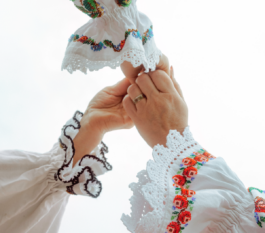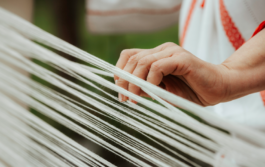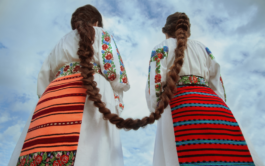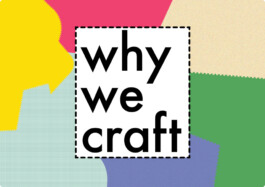Traditional Craftsmanship and the Six Basic Human Needs: Pathways to Sustainability & Fulfilment
Part II: Contribution, Growth, Significance
Written by Laura Aprilescu for #WhyWeCraft Stories
Did you read Part I?
Discover the incredible links between traditional craftsmanship and the Six Basic Human Needs.
Traditional crafts and the need for Contribution
The need for contribution is an essential part of what has helped humanity move toward progress, and crafts have been a major stepping stone.
Only a few years ago, a team of Bolivian women made headlines after they used Indigenous Aymara weaving patterns to craft a device that helps repair heart defects. The ingenious instrument is woven from a nickel-titanium alloy that can be delivered through a catheter to the heart, where it’s then expanded to repair a hole (Rapaport, 2018).
Bolivia is a highland country and South America’s lowest income state, and as heart defects are more common at high altitudes, cardiologists had often struggled to treat kids born with holes in their heart (de los Reyes, 2015). But despite the acute lack of resources, engineers teamed with weavers to identify the best pattern and materials for its construction. The artisans repeat an Andean cross or Chakana symbol up to 120 times to create the device, which has been registered under the Nit-Occlud ASD-R name (Rapaport, 2018). The Chakana is a strong symbol of the old cultures of the Andes and is considered the most complete, holy, geometric design of the Incas.
The community has thus found incredible ways to contribute to their own well-being and progress by capitalising on their textile heritage and craftsmanship. Their achievement has been recognised when the hand-crafted device was approved by South American, European, and Canadian regulators (Rapaport, 2018).
Traditional crafts and the need for Growth
To illustrate the link between traditional crafts and the human need for growth we turn to the Japanese art of repairing broken pottery known as Kintsugi.
Both a craft and a philosophy, Kintsugi treats breakage and repair as beautiful, valuable parts of an object’s history, rather than elements to disguise or reasons for disposal. By practicing it, artisans learned to embrace the flawed or imperfect, as well as the idea of change, and honour imperfection by illuminating the contours of the broken pieces with golden, silver or platinum lacquer. There’s also an innate inclination toward sustainability within the craft of Kintsugi, as it opposes the idea of wastage (Allwood et al., 2017).
A fragment from an insightful book, ’Flickwerk: The Aesthetics of Mended Japanese Ceramics’, highlights the links between this craft of wisdom and the human experience: “The vicissitudes of existence over time, to which all humans are susceptible, could not be clearer than in the breaks, the knocks, and the shattering to which ceramic ware too is subject” (Christy et al., 2008).
And for more than 400 years, this technique has taught generation after generation the role scars play in our growth as individuals and collectives, while also providing an outlet for healing.
Traditional crafts and the need for Significance
The last of basic human needs is the one for significance, often achieved through finding meaning and a sense of spirituality or a moral code that one resonates with.
Historically, many crafts reflected the religious or the spiritual beliefs of their communities, including the radiant Mexican weave called Ojo de Dios (God’s Eye).
A ritual tool and a cultural symbol, it originated in the Indigenous Huichol/Wixárika culture and its initial name meant “the strength to see and understand what is known”. It often reflects a confidence in all-seeing Providence or a collective ancestor (De Orellana, 1972).
When a child was born in the community, the father would weave the central eye and would then add a new one each year until the child would turn 5, a practice experienced almost as a meditative activity. The Ojo de Dios symbolised spiritual strength, as well as a profound communion with the environment (De Orellana, 1972). Sometimes it was also gifted by loved ones to a newborn or a sick child, as a way of providing protection and, indirectly, carrying the collective spiritual beliefs into the future.
These sacred weavings are still displayed in homes in Mexico and other Latin American countries, as well as in Mexican-American homes, as a way to keep the significance of their culture alive.
Back to Our Modern Times
As we can notice from our round-up alone, before modernity took over our lives with both its perks and its gloomier, addictive refuges, people used traditional crafts to meet not one, but an array of needs that remain universal to this day.
Many of these cultural practices have passed the test of time and by integrating them into our lives, we can find healthy ways of meeting our needs and work toward greater wellbeing, both on an individual and community level.
This is #Whywecraft!
References:
Allwood, J., et al., 2017. “Introduction: Industry 1.61803: The transition to an industry with reduced material demand fit for a low carbon future”. Philosophical Transactions: Mathematical, Physical and Engineering Sciences, 375(2095), 1-31. Retrieved August 26, 2021, from http://www.jstor.org/stable/44678452
Christy, J., Holland, H., Bartlett, C. I. (2008). “Flickwerk: The Aesthetics of Mended Japanese Ceramics”. Herbert Johnson Museum of Art, Cornell University. ASIN B009F3YENM.
De los Reyes, I., 2015. The Bolivian women who knit parts for hearts. [online] BBC News. Available at: https://www.bbc.co.uk/news/health-32076070
De Orellana, M., 1972. “God's Eyes”. Artes De México, (161), 11-12. Retrieved August 26, 2021, from http://www.jstor.org/stable/24317258
Rapaport, L., 2018. Bolivian women weave devices to patch holes in hearts. [online] Reuters.com. Available at: https://www.reuters.com/article/us-health-heart-device-crafting-idUSKCN1GP309
Read also Part I: Love, Certainty, Novelty
Traditional Craftsmanship and the Six Basic Human Needs: Pathways to Sustainability & Fulfilment
Part II: Contribution, Growth, Significance
Written by Laura Aprilescu for #WhyWeCraft Stories
Did you read Part I?
Discover the incredible links between traditional craftsmanship and the Six Basic Human Needs.
Traditional crafts and the need for Contribution
The need for contribution is an essential part of what has helped humanity move toward progress, and crafts have been a major stepping stone.
Only a few years ago, a team of Bolivian women made headlines after they used Indigenous Aymara weaving patterns to craft a device that helps repair heart defects. The ingenious instrument is woven from a nickel-titanium alloy that can be delivered through a catheter to the heart, where it’s then expanded to repair a hole (Rapaport, 2018).
Bolivia is a highland country and South America’s lowest income state, and as heart defects are more common at high altitudes, cardiologists had often struggled to treat kids born with holes in their heart (de los Reyes, 2015). But despite the acute lack of resources, engineers teamed with weavers to identify the best pattern and materials for its construction. The artisans repeat an Andean cross or Chakana symbol up to 120 times to create the device, which has been registered under the Nit-Occlud ASD-R name (Rapaport, 2018). The Chakana is a strong symbol of the old cultures of the Andes and is considered the most complete, holy, geometric design of the Incas.
The community has thus found incredible ways to contribute to their own well-being and progress by capitalising on their textile heritage and craftsmanship. Their achievement has been recognised when the hand-crafted device was approved by South American, European, and Canadian regulators (Rapaport, 2018).
Traditional crafts and the need for Growth
To illustrate the link between traditional crafts and the human need for growth we turn to the Japanese art of repairing broken pottery known as Kintsugi.
Both a craft and a philosophy, Kintsugi treats breakage and repair as beautiful, valuable parts of an object’s history, rather than elements to disguise or reasons for disposal. By practicing it, artisans learned to embrace the flawed or imperfect, as well as the idea of change, and honour imperfection by illuminating the contours of the broken pieces with golden, silver or platinum lacquer. There’s also an innate inclination toward sustainability within the craft of Kintsugi, as it opposes the idea of wastage (Allwood et al., 2017).
A fragment from an insightful book, ’Flickwerk: The Aesthetics of Mended Japanese Ceramics’, highlights the links between this craft of wisdom and the human experience: “The vicissitudes of existence over time, to which all humans are susceptible, could not be clearer than in the breaks, the knocks, and the shattering to which ceramic ware too is subject” (Christy et al., 2008).
And for more than 400 years, this technique has taught generation after generation the role scars play in our growth as individuals and collectives, while also providing an outlet for healing.
Traditional crafts and the need for Significance
The last of basic human needs is the one for significance, often achieved through finding meaning and a sense of spirituality or a moral code that one resonates with.
Historically, many crafts reflected the religious or the spiritual beliefs of their communities, including the radiant Mexican weave called Ojo de Dios (God’s Eye).
A ritual tool and a cultural symbol, it originated in the Indigenous Huichol/Wixárika culture and its initial name meant “the strength to see and understand what is known”. It often reflects a confidence in all-seeing Providence or a collective ancestor (De Orellana, 1972).
When a child was born in the community, the father would weave the central eye and would then add a new one each year until the child would turn 5, a practice experienced almost as a meditative activity. The Ojo de Dios symbolised spiritual strength, as well as a profound communion with the environment (De Orellana, 1972). Sometimes it was also gifted by loved ones to a newborn or a sick child, as a way of providing protection and, indirectly, carrying the collective spiritual beliefs into the future.
These sacred weavings are still displayed in homes in Mexico and other Latin American countries, as well as in Mexican-American homes, as a way to keep the significance of their culture alive.
Back to Our Modern Times
As we can notice from our round-up alone, before modernity took over our lives with both its perks and its gloomier, addictive refuges, people used traditional crafts to meet not one, but an array of needs that remain universal to this day.
Many of these cultural practices have passed the test of time and by integrating them into our lives, we can find healthy ways of meeting our needs and work toward greater wellbeing, both on an individual and community level.
This is #Whywecraft!
References:
Bhattacharya, S., 1976. “Cotton Mills and Spinning Wheels: Swadeshi and the Indian Capitalist Class”, 1920-22. Economic and Political Weekly, 11(47), 1828-1834. Retrieved August 26, 2021, from http://www.jstor.org/stable/4365116
Buono, A., 2015. “Historicity, Achronicity, and the Materiality of Cultures in Colonial Brazil”. Getty Research Journal, (7), 19-34. doi:10.1086/680732
Halunga, O., 2020. Povestea Iei/Timiş: Iile îngropate la Sânnicolau Mare de ţărăncile deportate în Bărăgan. [online] Agerpres.ro. Available at: https://www.agerpres.ro/cultura/2020/06/24/povestea-iei-timis-iile-ingropate-la-sannicolau-mare-de-tarancile-deportate-in-baragan-comorile-banatului-de-campie--528682
Marineasa, V. and Vighi, D., 2020. The Romanian Riveter: Draft of A Requiem from The Pentecost ’51. Fragments On the Deportation in Bărăgan. [online] European Literature Network. Available at: https://www.eurolitnetwork.com/the-romanian-riveter-draft-of-a-requiem-from-the-pentecost-51-fragments-on-the-deportation-in-baragan-by-viorel-marineasa-daniel-vighi-translateed-by-antuza-genescu/
Vultur, S. 1995. “De la reconstitution ethnographique à travers les récits de vie”. Ethnologie Française, 25(3), 473-483. Retrieved August 25, 2021, from http://www.jstor.org/stable/40990061
Read also Part I: Love, Certainty, Novelty
Endorsed by

Powered by

Project developed under the umbrella
of the Cultural Intellectual Property Rights Initiative®

This activity was a winner of the 2020 EU Social Innovation Competition from the European Union’s Horizon 2020 research and innovation programme.

Follow us
Our Linkedin page
Instagram Community
Our Youtube channel (soon)
© 2021-2024 Asociația WhyWeCraft, all rights reserved - WhyWeCraft®
LEARN WITH US
WORK WITH US

BE PART OF THE MOVEMENT FOR CULTURAL SUSTAINABILITY IN FASHION
Endorsed by

Powered by

Project developed under the umbrella
of the Cultural Intellectual Property Rights Initiative®

This activity was a winner of the 2020 EU Social Innovation Competition from the European Union’s Horizon 2020 research and innovation programme.

Follow us
Our Linkedin page
Instagram Community
Our Youtube channel (soon)
© 2021 Asociația WhyWeCraft, all rights reserved - WhyWeCraft®


